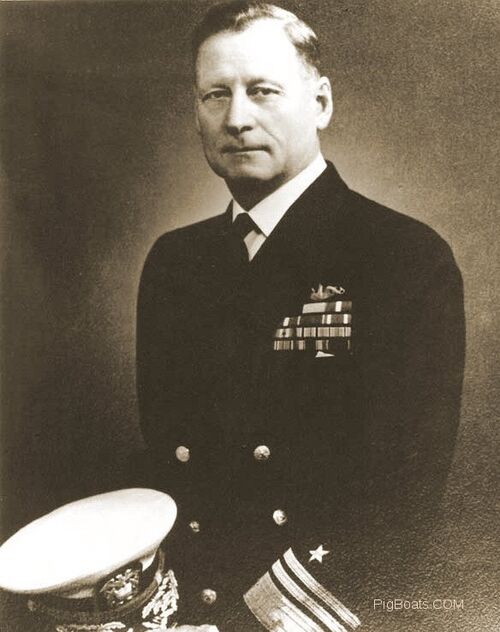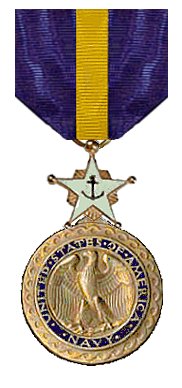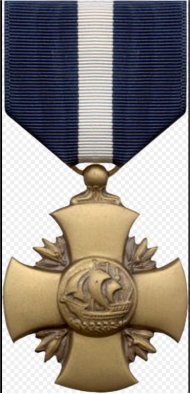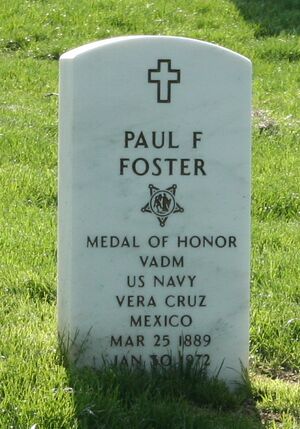Foster
Paul Fredrick Foster

Born to parents Festus and Lillie Foster March 25, 1889 in Wichita, Kansas. Paul was the second in the family of children that would eventually number five. He had an older brother Carol H. that was five years older, born in 1884. A younger brother, Ralph B. was born in 1891. A sister, Dorthy B. was born in 1896 after the family had moved to Oklahoma. Youngest brother, Festus F. was born in 1899, also in Oklahoma.
By 1907 Paul Foster had secured an appointment to the Naval Academy from the State of Idaho, were presumably the family had moved next. It was noted in the newspapers on; 'September 3, 1910 that Paul F. Foster, of Idaho, was named as cadet commander, or 'five striper,' of a midshipman's brigade, the highest honor open to a midshipman during the course of a cruise based on the efficiency and conduct shown during the cruise.' He graduated with the class of 1911.
After graduation Foster was assigned to the USS Washington ACR-11, was a United States Navy Tennessee-class armored cruiser, later renamed Seattle to free the name up for the Battleship Washington BB-47. In December of 1911 he was transferred to the Battleship Utah that had just been commissioned in August 31, 1911.
On May 30, 1912 there was a parade in Brooklyn, NY for the Grand Army of the Republic, celebrating Civil War and Spanish American War veterans. The parade was made up of all the military services and now, Ensign Foster, was a chief of a section of sailors from the USS Utah marching in the parade.
In October of the same year the Utah participated in the Presidential Revue on the Hudson River.
Also in October Foster had orders sending him to the destroyer USS Perkins DD 26 but after only a few weeks he was transferred back to the Utah. Why this was is unexplained.

Still attached to the Utah Foster was aboard when the blockade of Vera Cruz, Mexico was put into effect. When landings were ordered to return civil order to the town Foster was given the third company of the Utah battalion command. He was known as the 'boy officer' but he and his men performed bravely and captured the police station and fortified it. He secured his area and became the defacto "...chief of police, provost marshal, lord chief justice...", according to some newspapers. In fact he expected to to relieved by a senior officer for this duty but they defaulted to him these jobs.
Snipers were still active and the sailors under Foster were tasked to clean up these areas and capture the shooters. Foster administered justice to these men when they were brought before him. Many were tasked to clean up the mess and destruction they created.
Due to this action taken by the US sailors at Vera Cruz 11 were to be awarded the Medal of Honor. At that time officers were exempt from the awarding of this medal. On March 3, 1915, the rules were amended and Navy, Marine Corps, and Coast Guard officers became eligible for the Medal of Honor.
For his actions during this conflict Paul F. Foster was award the Medal of Honor. The citation reads;

Medal of Honor
"The President of the United States of America, in the name of Congress, takes pleasure in presenting the Medal of Honor to Ensign Paul Frederick Foster, United States Navy, for distinguished conduct in battle attached to the U.S.S. UTAH during the engagements of Vera Cruz, Mexico, 21 and 22 April 1914. In both days' fighting at the head of his company, Ensign Foster was eminent and conspicuous in his conduct, leading his men with skill and courage.
General Orders: War Department, General Orders No. 177 (December 4, 1915)
Action Date: April 21 - 22, 1914
Service: Navy
Rank: Ensign
Division: U.S.S. Utah"
In early December of 1914 Foster was transferred to the USS Prairie AD-5, she was an auxiliary cruiser from the Spanish American War. The Prairie was acting as a school ship for the training of men and officers for the submarine service. He was sent to the USS G-4 on February 21, 1915.
On March 7, 1915 while aboard the G-4 he was commissioned a Lieutenant jg.
The G-4 was the only foreign designed submarine ever built by the US Navy. She was a design by the Italian engineer Cesare Laurenti who had designed submarines for Italy and Britan. She was the first submarine in the US Navy with stern torpedo tubes. Her design was far from perfect and rolled so badly that attempts were made in install gyroscopes in 1916 to see if the rolling could be lessened. The attempt was a failure. Foster was now the Commanding Officer of the G-4 during this refit. She also had considerable mechanical failures. She was decommissioned in 1919.
On April 11, 1917 as the US was entering World War 1 Foster was still the commanding officer of the G-4 in the Third Submarine Division stationed at Newport, RI.
Relocating to Ireland in December 1917, he was assigned to the submarine tender Bushnell in Bantry Bay, Ireland. Foster was temporarily promoted to Lieutenant in May 1918. While serving in Irish waters, he took command of the submarine L-2. Lieutenant Foster was awarded the Distinguished Service Medal for his role in the sinking of the German submarine UB-65 off the Irish coast on 10 July 1918.

"The President of the United States of America takes pleasure in presenting the Navy Distinguished Service Medal to Lieutenant Paul Frederick Foster, United States Navy, for exceptionally meritorious service in a duty of great responsibility as Commanding Officer of the U.S.S. AL-2, in an encounter with an enemy submarine on 10 July 1918, in which the enemy submarine was sunk.
General Orders: Authority: Navy Book of Distinguished Service (Stringer)
Action Date: July 10, 1918
Service: Navy
Rank: Lieutenant
Company: Commanding Officer
Division: U.S.S. AL-2"
(Though the medal was not enacted until 1919 it was retroactive to 1917)
By October of 1918 he is back in the US and he is noted in the newspapers as being married, his wife's name is Isabelle and they are remarked in the Society Pages as having checked into the Hotel Astor in New York.
April 3, 1919 the USS G-2 was decommissioned and was designated as a target for testing depth charges and ordnance nets in Niantic Bay, Conn. During inspection by a six-man maintenance crew on 30 July 1919, the G-2 suddenly flooded and sank at her moorings in Two Tree Channel near Niantic Bay. She went down in 134 fathoms, drowning three of the inspection crew. Foster was assigned to the naval board of inquiry looking into the accident.
The 1920 US Census shows that he and his wife are living with his In-Laws in North Hempstead, NY. But his duty station is noted as being the Navy Yard in Washington DC.
In November 1922 the navy premiered a movie called 'Rolling Down to Rio With Secretary Hughes', a documentary made of the trip of the Secretary of State Charles Evans Hughes trip to Brazil. The premier was attended by the Commander of the Atlantic Fleet, Admiral Hilary Jones and members of his staff, one of which was Paul Foster.
When the cruiser USS Trenton CL-11 was commissioned on Aprol 19, 1924 Lieutenant Commander Paul Foster was aboard as the Gunnery Officer. In mid-October, while TRENTON was conducting gunnery drills in the Norfolk area, powder bags in her forward turret exploded, killing or injuring every member of the gun crew. Foster noting the difficulties of rescuing the men in the turret through the access door, or of extinguishing the fire from the forecastle Lieutenant Commander Foster entered the turret from the upper handling rooms, took the fire hose which was passed to him from without and extinguished the fire in the turret and in the clothing of the members of the crew.
For this action Paul F. Foster was awarded the Navy Cross making him the first person in the Navy to be awarded the three highest medals the Navy could award. The Medal Of Honor, The Navy Cross and the Distinguished Service Medal.

The citation read: "The President of the United States of America takes pleasure in presenting the Navy Cross to Lieutenant Commander Paul Frederick Foster, United States Navy, for extraordinary heroism in the line of his profession on the occasion of the turret disaster on board the U.S.S. TRENTON on 20 October 1924. Noting the difficulties of rescuing the men in the turret through the access door, or of extinguishing the fire from the forecastle, and with total disregard for his own safety, Lieutenant Commander Foster entered the turret from the upper handling rooms, took the fire hose which was passed to him from without and extinguished the fire in the turret and in the clothing of the members of the crew.
Action Date: October 20, 1924
Service: Navy
Rank: Lieutenant Commander
Company: Executive Officer
Division: U.S.S. Trenton"
In 1927 Foster attended the opening of the Soldiers and Sailors Club on Lexington Ave in New York as one of many military officials attended.
With the birth of his first child, Paul Fredrick Foster, Jr, in January 1929 Foster resigns his active commission and remains on the Reserve Lists. He joined a Wall Street Firm and started a life in Investment Baking. The family is living in North Hempstead, NY by the 1930 Census.
In 1931 it has been noted that the family lived in Great Neck, Long Island, New York.
In 1932 he is listed as a stock promoter and he had secured a $19,000 judgement against former New York State Senator John A. Hastings for unpaid bills. He had the former Senator's 1932 Pierce Arrow seized by the Sheriffs Office as he was trying to dive away from the court house leaving him and his chauffeur standing on the sidewalk.
In January of 1932 Foster was voted president of the Soldiers and Sailors Club in New York City.
In 1933 he and his wife are patrons of the New York League of the Women's Overseas Service. They attended a bridge club social to raise funds for the service.
The intervening years are fairly void of information until the 1940 Census where he shows up as the possible proprietor of a hotel, he also lists himself as an Executive and Broker and Engineer. Sounds like he has lots going on.
He was recalled to active duty in 1941 by President Franklin Roosevelt. Roosevelt had him conduct naval inspections for him personally from 1942 to 1943. He served as Assistant Naval Inspector General, 1943 to 1946 and retired as a Vice Admiral, United States Navy Reserve in October 1946.
He later was with the Atomic Energy Commission, 1954 to 1959, serving as Deputy General Manager in 1959. He was United States Representative to the International Atomic Energy Agency, Vienna, 1959 to 1961.

Findagrave.com
Paul Fredrick Foster died on January 30, 1972. He is buried Arlington National Cemetery, Arlington, Virginia, Plot: Section 5, Lot 106.
Page created by:
Ric Hedman & David Johnston
1999 - 2023 - PigBoats.COM©
Mountlake Terrace, WA, Norfolk, VA
webmaster at pigboats dot com
